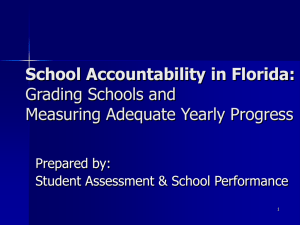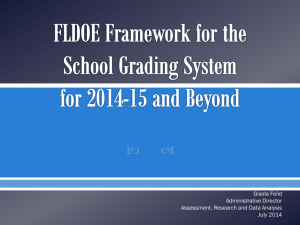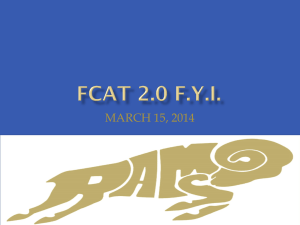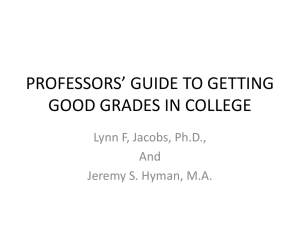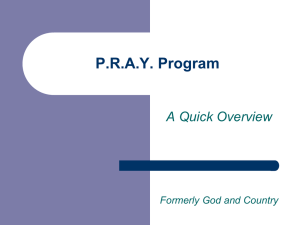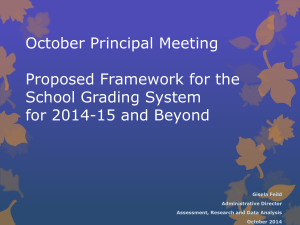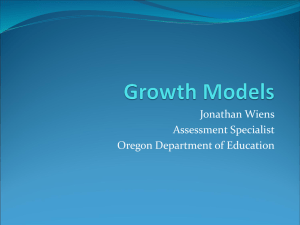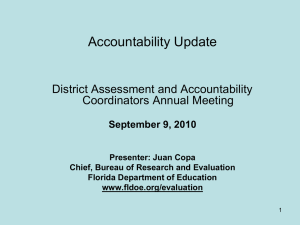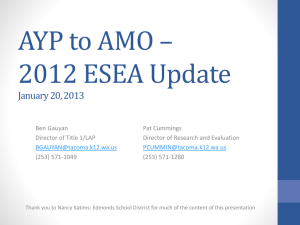Grading Schools And Measuring Adequate Yearly Progress
advertisement
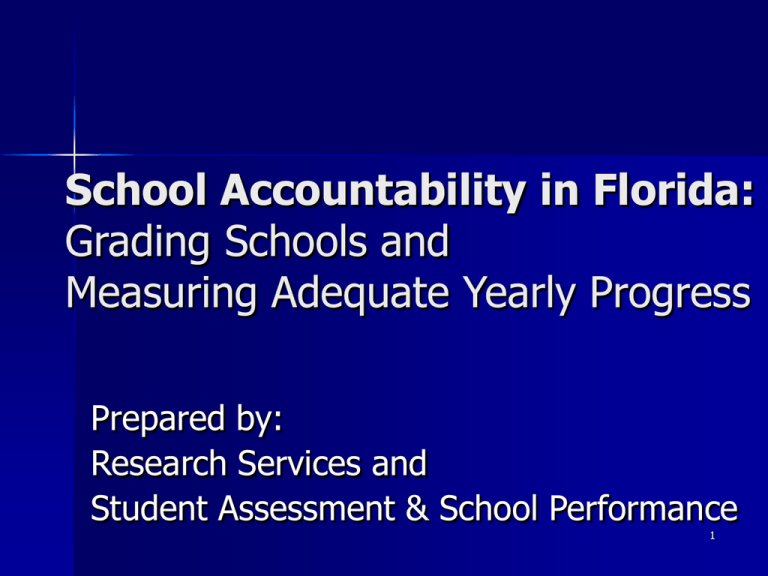
School Accountability in Florida: Grading Schools and Measuring Adequate Yearly Progress Prepared by: Research Services and Student Assessment & School Performance 1 Two Accountability Systems School Grades are a component of Florida’s A++ Plan Adequate Yearly Progress (AYP) is a component of the Federal No Child Left Behind legislation 2 School Grades Schools are graded by earning points based on the percentage of students who reach specific criteria in each of 8 measures. First four components: Percent Achieving High Standards • Level 3 and above in reading (grades 3-10) • Level 3 and above in math (grades 3-10) • Essay Level 3.5 and above in writing (grades 4, 8, and 10) • Level 3 and above in science (grades 5, 8, and 11) 3 School Grades Next four components: Learning Gains • Learning gains in reading (grades 3-10) • Learning gains in math (grades 3-10) • Learning gains of lowest 25% in reading (grades 3-10) • Learning gains of lowest 25% in math (grades 3-10) Retained 3rd graders & students in grades 4-10 with FCAT scores for two consecutive years are included in learning gains computations, regardless of LEP or ESE status. 4 How Are Learning Gains Defined? • • • Improving from one FCAT Achievement Level to the next Level (example: Level 3 to Level 4) Maintaining FCAT Achievement Level within Levels 3, 4, or 5 Remaining within FCAT Levels 1 or 2 and achieving more than one year’s growth on the FCAT developmental scale 5 Developmental Scale Score Learning Gains Cutpoints Grade Level 3 to 4 4 to 5 5 to 6 6 to 7 7 to 8 8 to 9 9 to 10 Reading 230 166 133 110 92 77 77 Math 162 119 95 78 64 54 48 Students must register a gain of one point more than the numbers listed above. 6 Learning Gains • • Students who drop a level (Level 4 to 3 or Level 5 to 4) are not be counted as learning gains Retained students who are Level 1 or Level 2 must improve at least one level in order to be counted as making learning gains 7 Writing • Achievement Levels were provided for first time in 2006-07. • As of now, achievement levels will not be incorporated into the grade computation for 2007-08. • If a school tests 30 or fewer students in Writing or does not have grade 4, 8, or 10, the District average score for Writing is substituted. This includes schools who do not serve one or more of the tested grade levels. 8 Science • Achievement Levels were provided for first time in 2005-06. • Science Achievement Levels were incorporated in school grades for first time in 2006-07. • If a school tests 30 or fewer students in Science or does not have grade 5, 8, or 11, the District average score for Science is substituted. This includes schools who do not serve one or more of the tested grade levels. 9 Grade Scale Grade Points A 525-800 B 495-524 C 435-494 D 395-434 F 0-394 10 School Grade Computation Reading Mathematics Writing Science High Standards 67 75 Learning Gains 71 78 Lowest 25% 72 75 Grade 93 Total 26 557 A 11 Adequate Progress At least 50% of students in the bottom 25% must demonstrate learning gains in reading and math “A” Schools • Must register adequate progress in the current school year “B” and “C” Schools • Must register adequate progress in the current or prior school year Failure to make Adequate Progress for two consecutive years results in reduction of letter grade, regardless of number of points earned. 12 Bonus Points (High Schools) High Schools are eligible for 10 bonus points added to their total school grade points, if at least half the 11th and 12th grade students in the school retaking the FCAT meet the graduation requirement (score of 300). 13 Participation Rates “A” Schools • Must test at least 95% of students “B”, “C”, and “D” Schools • Must test at least 90% of students Failure to test at least 90% of students results in an “I” pending investigation and may result in a lowering of the letter grade. 14 Who Counts for School Grades? • • Students enrolled during the October and February FTE surveys Included for all components: – Standard Curriculum Students – ESE: Gifted, Hospital/Homebound, Speech Impaired – LEP: Enrolled in a ESOL program for more than 2 years prior to testing • Other ESE and LEP categories included in percent tested and learning gains. 15 No Child Left Behind Adequate Yearly Progress (AYP) Includes all students who took the FCAT and were enrolled during the October and February FTE surveys Performance by Subgroup – Total – White, Black, Hispanic, Asian, American Indian – Economically Disadvantaged – Limited English Proficiency – Students With Disabilities 16 Subgroups Must test at least 95% of each subgroup Subgroups count if: – 30 students and 15% of the school population OR – 100 students Students can be in more than one subgroup 17 Reading Mathematics 2013-14 2012-13 2011-12 2010-11 2009-10 60 58 2008-09 70 2007-08 2006-07 2005-06 2004-05 2003-04 2002-03 2001-02 Annual Raising of the Bar 100 90 80 62 50 40 30 20 10 0 18 Three Ways to Make AYP 19 1. Meeting Standard Criteria Each Subgroup: – 95% of students tested in Reading and Math – 58% at level 3 or above in Reading – 62% at level 3 or above in Math Total Group: – 1% increase OR 90% in Writing scores at 3.0+ – 1% increase OR 85% in graduation rate School Grade “A”, “B”, or “C” 20 2. Safe Harbor School-wide Participation rates, Writing, Graduation, and School Grade requirements met. Subgroup Participation rates, Writing, and Graduation requirements met. Decrease of at least 10% in the percent of non-proficient students. – A school has 50% of a subgroup level 1 or 2 in 2007-08. If that school had 55% or more in levels 1 and 2 during 2006-07, that school would make Safe Harbor for that subgroup and subject. 21 3. Growth Model School-wide Participation rates, Writing, Graduation, and School Grade requirements met. Subgroup Participation rates, Writing, and Graduation requirements met. Percent of students on track to be proficient in 3 years or less 22 3. Growth ModelOn Track to Proficiency A trajectory is developed for each student. Developmental Scale Scores Student must reduce the gap between their prior year score and proficiency by at least 33% per year. 23 3. Growth ModelOn Track to Proficiency 2000 1800 1715 1600 1400 1245 DSS 1200 On Track Trajectory Student 1 973 1000 800 775 600 601 400 Student 2 305 305 200 0 4 5 6 7 Grade Intermediate on track trajectory scores represent one third of the difference between the baseline and proficient score. 24 3. Growth ModelOn Track to Proficiency Grade Of Test Used As Enrollment The Basis For Trajectory Test Used As Target For Proficiency Years In Trajectory Percent Of Difference Closed Per Year 3 3 6 3 33% 4 3 6 3 33% 5 4 7 3 33% 6 5 8 3 33% 7 6 9 3 33% 8 7 10 3 33% 9 8 10 3 33% 10 9 10 2 50% 25 Correlation Between School Grades and AYP School Grades and AYP are based on separate computational methods. In prior years, “Provisional AYP” status was awarded to schools that did not meet AYP criteria, but earned an “A” or “B” designation. These schools still have same consequences as schools that do not meet AYP. “D” or “F” schools cannot make AYP, even if all AYP criteria are met. 26 For Additional Information Florida Department of Education http://schoolgrades.fldoe.org/ Student Assessment & School Performance http://www.broward.k12.fl.us/studentassessment/ Research Services http://www.broward.k12.fl.us/research_evaluation/ResearchServices.htm School Improvement http://www.broward.k12.fl.us/schoolimprove/ 27
